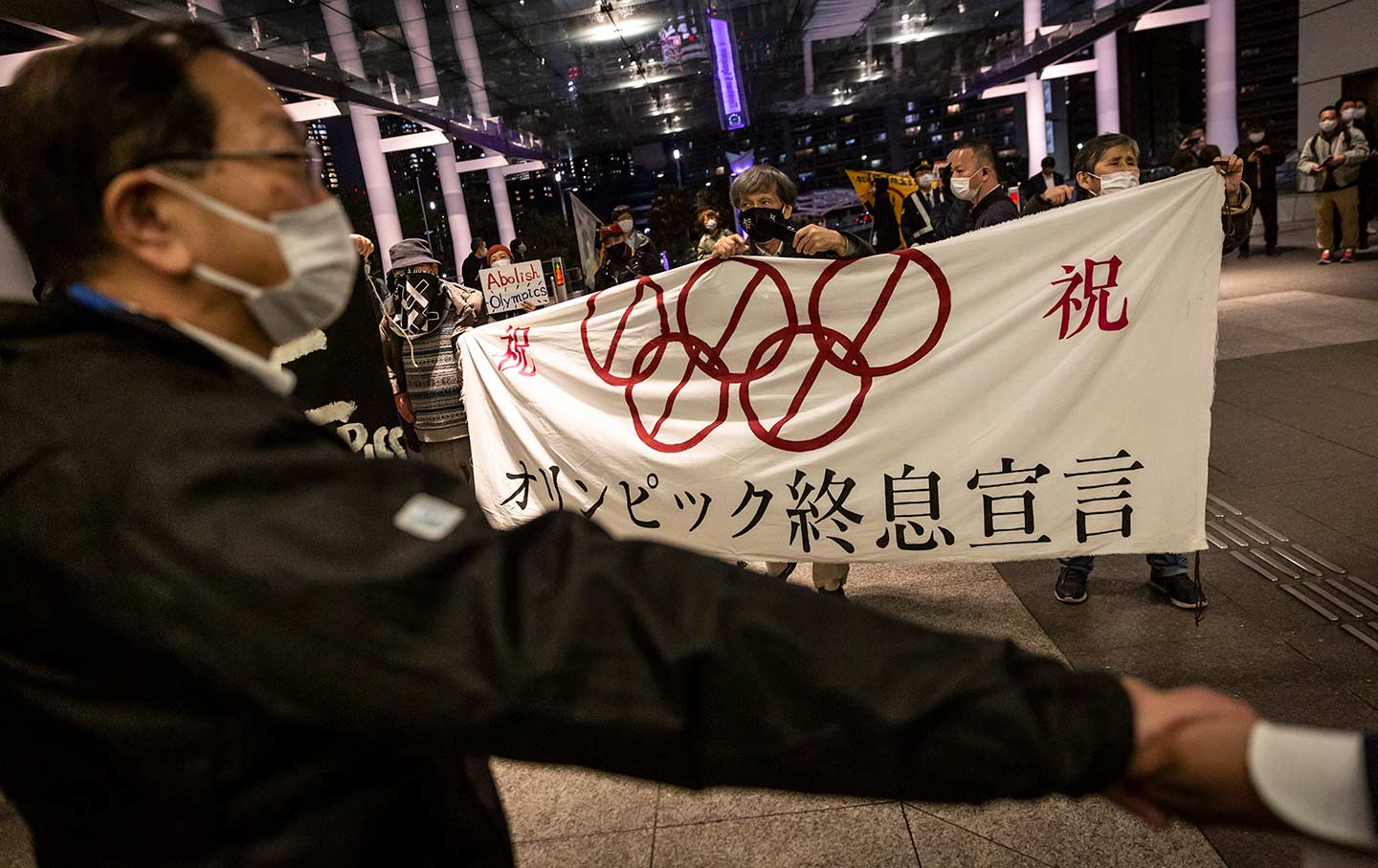By paying lip service to the Fukushima disaster and the nuclear bombs dropped on Japan, these games are downplaying the growing danger of nuclear catastrophe.
By Alyn Ware


Police officers hold back protesters demonstrating against the Tokyo Olympics outside the headquarters of the IOC’s Tokyo Organizing Committee on March 25, 2021. (Yuichi Yamazaki / Getty Images)
The Olympics are supposed to be a tangible symbol of global cooperation and peaceful competition. But the games carry a lot of baggage—not only from the pandemic but also from the Fukushima disaster and Japan’s nuclear politics.
As Covid cases spread in the Olympic Village and in Tokyo, protesters continue to demand the Olympics be canceled, and they continue to be ignored. But the tone-deafness of these Olympics goes back further—to the Fukushima nuclear disaster. In 2019, then–Prime Minister Shinzo Abe dubbed the Tokyo Olympics the “Recovery Games,†meant “to showcase the affected regions of the tsunami†and the nuclear meltdown of 2011, which continues to pose threats today.
That’s why some Olympic events are being held in Fukushima’s Azuma Stadium, and why Olympic torch runners have been routed through Fukushima prefecture, hitting what the official Olympic website calls “places of interest†near the Fukushima Daiichi nuclear plant. It started at J-Village, a former logistics hub for crews working to remediate the stricken reactors, now a sports complex, where Greenpeace detected a radiation hot spot in late 2019. It passed through Ōkuma and Futaba, where the plant is located, and other nearby towns long abandoned after the disaster.
This is intended to project an image of recovery and normalcy to the world. But it’s government propaganda, deaf to citizens’ concerns, and blind to ongoing threats. Fukushima Daiichi continues to leak radioactivity. New radiation hot spots and other impacts are being discovered all the time.
This sort of Olympic spin tactic has been used before. In the 1964 Tokyo Olympics, the government sought to portray Japan as a modern industrial nation with its own nuclear research program. Yoshinori Sakai, born in Hiroshima on the day the atomic bomb was dropped, lit the Olympic flame. A scant year and half after the Cuban missile crisis, this gesture soft-pedaled the dangers of nuclear technology, nuclear weapons, and the burgeoning arms race.
Today, the tone-deafness continues. This month, on the anniversary of the Trinity nuclear tests that enabled the atomic bombings of Japan, IOC President Thomas Bach went to Hiroshima to lay a wreath at a memorial, prompting an angry response. “President Bach using the image of ‘a peaceful world without nuclear weapons’ only to justify holding of the Olympics by force under the pandemic is a blasphemy to atomic bombing survivors,†a coalition of civic groups wrote. “An act like this does nothing but do harm to the global nuclear weapons ban movement.
Billions watching the games are imbibing the idea that, protests notwithstanding, Covid, Fukushima, the atomic bombings, and rising nuclear dangers today pose no impediment to normalcy. This should be countered with factual context and truth-telling.
Nuclear Games, a new documentary available online, attempts this by contrasting the Olympic ideals of peace and humanity with our history of nuclear violence and inhumanity (full disclosure: My organization Basel Peace Office is one of several NGOs helping with the project). It uses manga and interactive content to counter Olympic spin and teach mass audiences, including young people, Nuclear History 101: the Cuban missile crisis, Chernobyl, the victims of uranium mining and nuclear testing, the North Korean nuclear program.
We urgently need remedial education on nuclear issues. Most millennials believe nuclear war will occur within the next decade, yet they also rank nuclear weapons as the least important of 12 global issues. They’re both justifiably anxious and badly misinformed.
Achieving basic nuclear literacy is indispensable now. Nuclear dangers are more acute than in 1964, the risk of nuclear war is growing, and the arms control regime is failing. This year, the Bulletin of the Atomic Scientists moved its Doomsday Clock ahead to 100 seconds before midnight—closer to the zero hour than during the Cuban missile crisis.
Nuclear weapons states are turning away from arms control and embarking on a second Cold War–style arms race. As China builds missile silos and Russia builds new types of nuclear weapons, the United Kingdom and Pakistan are expanding their nuclear arsenals, the United States is spending billions to “modernize†its arsenal, and other nuclear powers are following suit.
To be sure, there is pushback. Some 1,200 policy-makers, celebrities, academics, and civil society leaders issued a joint letter to presidents Biden and Putin flagging growing nuclear dangers and urging them to adopt a no-first-use policy to defuse nuclear tensions and facilitate disarmament. US Senators Ed Markey and Jeff Merkley and their colleagues on the Nuclear Arms Control Working group recently called on Biden to guide the Nuclear Posture Review towards a pledge of no first use and the elimination of new types of nuclear weapons.
But such things can hardly compete with a two-week Olympic media blitz that normalizes nuclear disasters and shrugs at rising nuclear dangers, which illustrates why we need a new drive for mass nuclear literacy. With arms control in retreat, an informed citizenry could be our last, best line of defense.
Alyn Ware, a peace and disarmament educator, is global coordinator of Parliamentarians for Nuclear Non-proliferation and Disarmament, director of the Basel Peace Office, and cofounder of the Global Campaign for Peace Education. He is a winner of the Right Livelihood Award and a three-time Nobel Peace Prize nominee.
This article was published on July 29 at The Nation.
